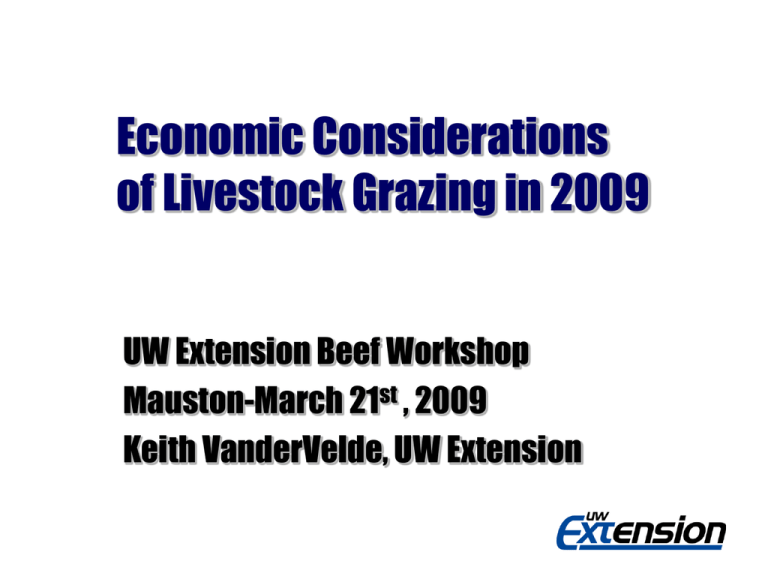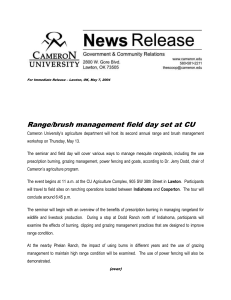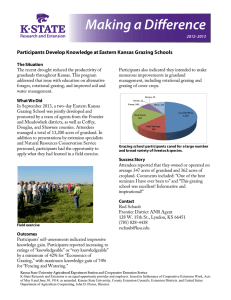Economics of Grazing 2009 (29 slides, 283 KB .ppt)
advertisement

Economic Considerations of Livestock Grazing in 2009 UW Extension Beef Workshop Mauston-March 21st , 2009 Keith VanderVelde, UW Extension Economic Considerations Is Grazing a Profitable Enterprise ? Yes, • BECAUSE it INCREASES PRODUCTION and REDUCES COST if done properly. Economic Considerations What if you were told of a special crop production system that would increase output by at least 30% and reduce your cost by 50% I think most of you would not have any trouble adapting to such a system Economic Considerations In Most Situations Managed Rotational Grazing will do both increase production and reduce cost by: • • • • Increasing carrying capacity Increase ADG Improved herd health Longer productive life It also results in larger calf crops and producers are more aware of the health of the herd Economic Considerations In Most Situations Managed Rotational Grazing will do both increase production and reduce cost by: • • • • • • Reducing Feed cost Reducing Fertilizer Needs Greater weed control Less Fuel needs Less Labor(yes you move the cows but they harvest) Less manure to haul It also results in more free and family time to get away Economic Considerations Is Grazing a Profitable Enterprise Do I have the Necessary • • • • • Land Cattle Fencing Labor Capital Economic Considerations Profitability Do a Balance Sheet Project Expenses and Income Look at History of Operations Remember Most Markets are Cyclical • Get in when prices are low • Get out or reduce inventory when prices up Economic Considerations Grazing Economics Beef-Cow industry looks break even in 2009based on Cattle-Fax projections Time to reduce input cost One of the common pitfalls is increased expenses. If income goes up and expenses also increase we have lost a profit opportunity Grazing Economics Grazing Economics Cow /calf economic factors are • • • • • • Reproductive efficiency Weaning weight Sales price Feed Cost Market Cycle Fixed Costs Grazing Economics Managed Intensive Grazing (MIG) • Offers greater management Flexibility • Comes at an added cost – Fence – Water systems – Labor – Higher level of management required – Greater investment per animal Fencing Cost One of the largest expenses in Grazing Many different options but some rules apply • • • • Have secure perimeter fence Use temporary or portable fence in cells Use the lay of the land to your advantage Be flexible in cell sizing Cost of Fencing • • • • • • • • 48” woven wire, one barb-----------$1.07/foot 5 barbed wire fence------------------$0.83/foot High tensile 8 strand 12.5 gauge---$0.56/foot High tensile 5 strand electric-$0.14/foot Polywire fence(interior use only)--$0.03/foot Plastic Electric 4 Tape Wide--$0.89/foot Electric Rope, steel, 3 strand-$0.16/foot Plastic Coated non electric, 3 tapes--$2.46/foot Shape effect on Fencing Requirements 744 feet 836 feet Length=2 X Width 888 feet 1007 feet 951 feet Length=4 X width 1,040 feet Cost of Reseeding Most sources recommend frost seeding as the best and most cost effective method of establishing and improving pastures With frost seeding the costs are primarily the cost of the seed What about Equipment One of the primary benefits of Grazing is the Machinery necessary • Many producers limit themselves to a: – Tractor with loader – Manure spreader – One hay making set of equipment(square bales or round baler) Time Requirements Remember Cattle Need to be Moved • Make sure you have the time and labor to move cattle to new paddock • You must learn to know when is it time to move them • Timing will vary with the amount of available pasture Winter Feed Supply Winter feeding often accounts for 70 % of the total feed cost for a beef cow-calf operation As a grazer our goal is to reduce the amount of feed brought to the cow and to have the cow go get it herself • this reduces costs • gets the manure in the field Wintering Costs Stockpiling forage is recommended • Set pastures aside for late fall and winter grazing • Consider corn stalk grazing or other refuse grazing • Consider windrowing in Nov and let the cows eat the forage out of the windrow when snow is present Reducing Winter Feed Cost Purchase cheap hay not suitable for dairy and horse owners during the summer Substitute cheap corn and oats for forage Remember 10 lbs of a 50/50 corn oats mix is only $.60 with today's grain prices Look at cheap alternatives, i.e. potato waste, sweet corn silage, candy waste Cutting Winter Feed Cost Figure out a way to feed a cow for $150 or less from Nov-April Have some pasture available for April 15 grazing Try to keep the manure out of the feeding area and in the pastures where it will fertilize next years forage supply Fertilizer Costs and Pastures Very high prices UWRF Research shows fertilize May 1st Only fertilize improved grasses • ?? Bluegrass Work to establish legumes in pastures • Frost seed-red & white clover, orchardgrass, Italian rye grass • Drill into grass sod-legumes Make it Profitable Stocking Rate Is Critical • Goal is to maximize production per acre and production per head • Greatest profits are not generated by the greatest production • Economically optimum stocking rate will occur somewhere between the point of maximum output and maximum per head performance Calf gain under various grazing systems—Iowa State University Using a 100 cow herd for the analysis Return to operator labor, capital and management per acre • Brome – $99.53 w/high, 51.30 w/low intensity • Mixed grass/legume – $140 w/high, $119 w/low and $108 w/continuous – $99.53 w/high, 51.30 w/low intensity Importance of individual animal performance Stocker cattle rule of thumb It takes 150 lbs of gain for a stocker to cover it’s costs 200 lbs of gain returns 75 lbs of profit 250 lbs of gain returns 125 lbs of profit Calf gain under various grazing systems—Iowa State University Two grazing intensities -high with one cow/calf pair per acre -low or continuous with 1.67 acres per cow/calf pair Two pastures-mixed legume and brome Calf gain under various grazing systems—Iowa State University and Nebraska Results: -on mixed grass/legume, ADG was similar but gain per acre was 100 lbs higher with MIG pasture -on brome grass , ADG was greater for low intensity but gain/ac was 60 lbs higher for MIG pasture University of Missouri Forage Research Data Comparison of 3 vs. 12 vs. 24 paddock system for cow /calf production Greatest return from 12 paddock system—the 24 had the highest production but this advantage was offset by more labor and material cost






